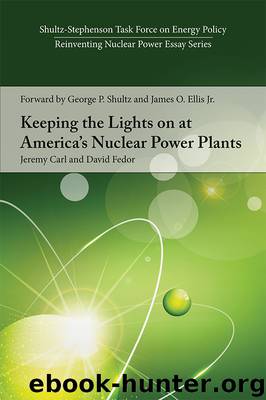Keeping the Lights on at America's Nuclear Power Plants by Carl Jeremy

Author:Carl, Jeremy
Language: eng
Format: epub
Tags: Nuclear, Energy, Energy policy, Renewables, Carbon, Pollution, Reactor, Clean energy, Energy security
Publisher: Hoover Institution Press
Published: 2017-03-12T16:00:00+00:00
Congress: Congress could direct federal agencies to use taxpayer money to provide additional sources of income and stability to nuclear owners (or reduce existing subsidies to nuclear’s competitors).
Subsidies
The federal government has shown a general willingness across Congresses controlled by both political parties to use taxpayer money to subsidize energy technologies desired by green energy advocates. These subsidies—including tax credits for wind, biomass, geothermal, solar, fuel cell, and cellulosic ethanol technologies; accelerated cost-recovery systems; loan guarantees; and other tax benefits—are described below. 64
A wind, biomass, and geothermal power production tax credit of approximately $24 per megawatt-hour production applies for the first ten years of operation in these facilities. This is the largest federal energy subsidy today. For example, the value of this credit for wind power alone in the United States is currently around $4 billion annually, and it is increasing alongside the rise in installed capacity of new wind. 65 Today, there is also a smaller production tax credit of about $11 per megawatt-hour for landfill gas and small hydropower generation. Though it occasionally lapses for short terms, the production tax credit has existed in some form since Congress enacted it in the Energy Policy Act of 1992. It was last extended in December 2015 and is currently set to decline in value before being phased out for new projects by the year 2020. The production tax credit is a major driver of wind power development in particular. New installations have plummeted each time the credit has been allowed to temporarily expire; experts estimate that the credit has been responsible for roughly half of new installations. At times over this policy’s history, developers were able to swap this production credit for a onetime investment tax credit of 30 percent of investment costs or cash grants (see below).
A solar, fuel cell, and small wind investment tax credit of 30 percent of investment costs applies to both commercial grid-scale and residential systems, as well as a 10 percent investment tax credit for micro-gas turbines, combined heat and power, and geothermal. The 2009 American Recovery and Reinvestment Act Section 1603 grant program allowed renewables developers to temporarily receive up-front cash grants from the government in lieu of the standard investment tax credit (for solar, and also for those periods when wind was eligible for an investment tax credit in place of the standard production tax credit). Originally slated to expire after 2016, the solar power portion of this tax credit was extended by Congress in 2015 through 2019 and will phase out through 2024. Like the production tax credit for wind, the investment tax credit has been a major enabler of solar power deployments that might otherwise be uneconomical.
A five-year modified accelerated cost-recovery system (MACRS) for solar, wind, fuel cells, geothermal, and micro-turbines allows tax deductions for these investments to be taken over five years (and about 52 percent of the total cost in the first two years) rather than using a slower straight-line depreciation method.
A cellulosic ethanol production tax credit is worth $1.
Download
This site does not store any files on its server. We only index and link to content provided by other sites. Please contact the content providers to delete copyright contents if any and email us, we'll remove relevant links or contents immediately.
The Secret History by Donna Tartt(16621)
The Social Justice Warrior Handbook by Lisa De Pasquale(11489)
Thirteen Reasons Why by Jay Asher(7788)
This Is How You Lose Her by Junot Diaz(5769)
Weapons of Math Destruction by Cathy O'Neil(5036)
Zero to One by Peter Thiel(4824)
The Myth of the Strong Leader by Archie Brown(4789)
Promise Me, Dad by Joe Biden(4447)
Beartown by Fredrik Backman(4415)
Stone's Rules by Roger Stone(4415)
How Democracies Die by Steven Levitsky & Daniel Ziblatt(4398)
The Fire Next Time by James Baldwin(4342)
100 Deadly Skills by Clint Emerson(4076)
A Higher Loyalty: Truth, Lies, and Leadership by James Comey(4032)
Rise and Kill First by Ronen Bergman(4012)
The David Icke Guide to the Global Conspiracy (and how to end it) by David Icke(3881)
The Farm by Tom Rob Smith(3872)
Secrecy World by Jake Bernstein(3782)
The Doomsday Machine by Daniel Ellsberg(3730)
